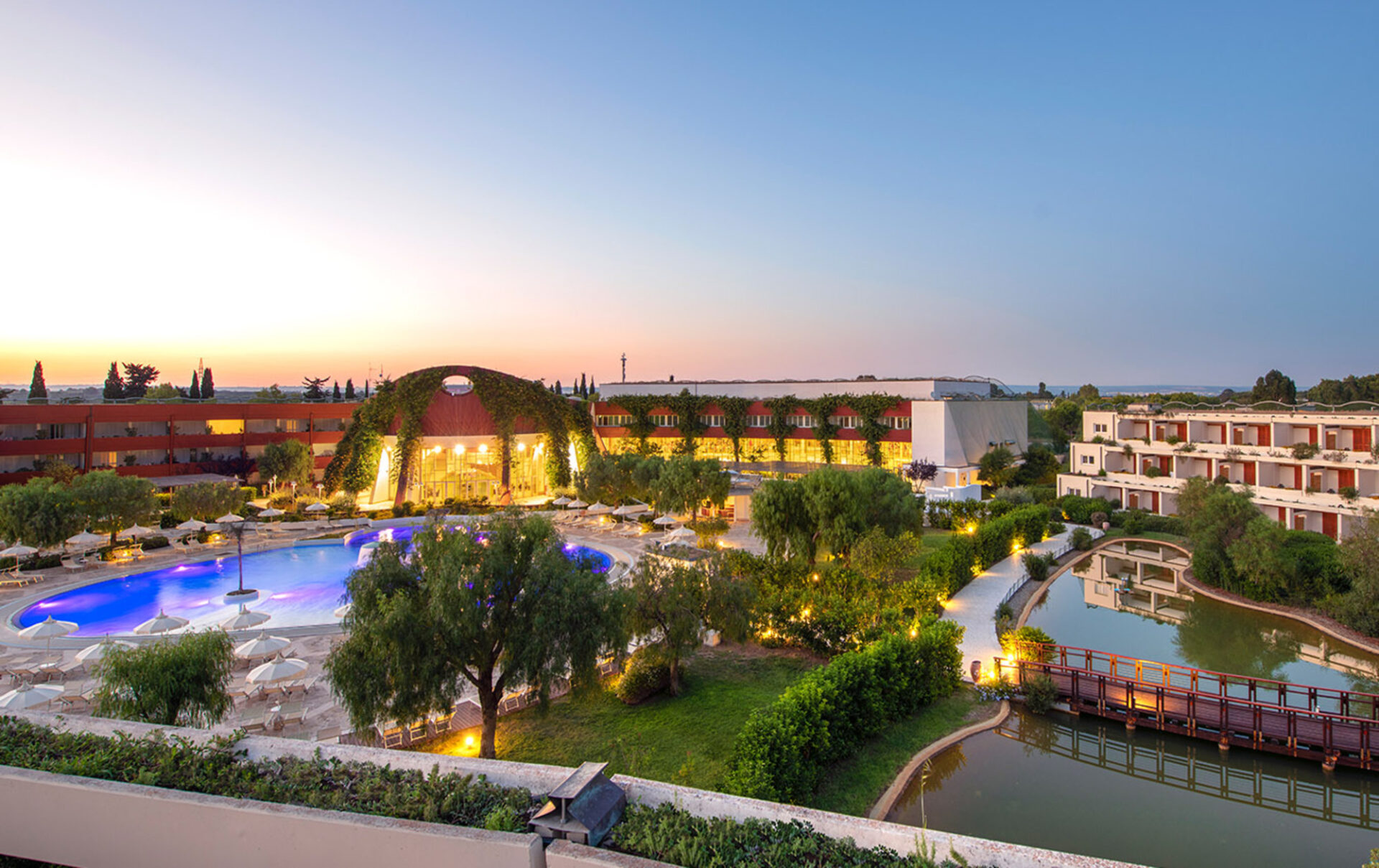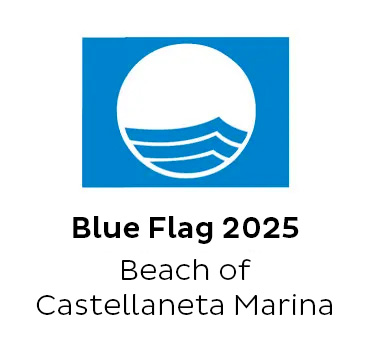Enjoy the benefits of the Bluserena world, starting with a 15% discount on your 2026 holiday.
CALANÈ RESORT
Apulia


CALANÈ RESORT


An oasis nestled into Puglia’s exquisite Stornara Nature Reserve, Calanè Resort is part of the stunning Ethra Reserve complex.
Distance 90 km – Just 17 kilometres from the city of Andria, Castel del Monte is Frederick II of Swabia’s 13th-century fortress, one of Puglia’s top tourist destinations. The imposing, impressive structure has an original octagonal shape that recurs throughout the structure, both in the courtyard and in various architectural elements, such as the eight towers. The shape and location correspond to the direction of the shadows during the solstice and equinox. The evocative decorative elements, such as the two crouching lions on either side of the entrance gate, are imbued with symbolism that combines elements of classical antiquity and Nordic and Islamic culture.
Distance 60 Km – The contrast between modernity and tradition, a distinct feature of southern Italy, is essential to Puglia’s charm–the new blends into settings where time seems to stand still. Alberobello, a UNESCO World Heritage Site in the Bari province, exemplifies this. The unique jumble of 1,500 Trulli is in the Monti and Aja Piccola districts, and its historic centre consists exclusively of these conical-shaped structures made from Murge plateau limestone and assembled from dry stone. The Trulli, found mainly in the Itria Valley between the provinces of Bari and Brindisi, have prehistoric origins and are still inhabited today.
Distance 50 km – The landscape of Matera embodies the contrast between the ancient and the modern, tradition and innovation. A UNESCO World Heritage Site since 1993, Matera is known worldwide as the city of the Sassi or the Underground City. Matera is not only the oldest inhabited nucleus in Basilicata and Southern Italy but is also among the world’s ten oldest inhabited cities, with settlements dating back some 10,000 years. The cave dwellings carved into the mountain were continuously inhabited from the Bronze Age until 1952, when a national law called for the forced eviction of approximately 15,000 residents. In addition to lodging museums, they’re the setting for several national and international cultural events today, leading to Matera’s designation as the 2019 European Capital of Culture.
Ostuni, the White City of Brindisi, rises resplendently, a jumble of white walls amid sun-drenched land, olive trees, and dry-stone walls. The gaze wanders to the horizon for a glimpse of the sparkling sea. Situated between the Itria Valley and Upper Salento, Ostuni is a fascinating hub famous not only for its pristine water and quality services, which were awarded a Blue Flag and Five Sails by Legambiente, but also for its valuable historical and cultural treasures. Martina Franca, on the Murgia’s eastern hills in the heart of the Itria Valley, rises majestically between the Ionian and Adriatic seas. It’s surrounded by a fascinating naturalistic landscape with the Bosco delle Pianelle Oriented Regional Nature Reserve replete with biodiversity and scenic trails. Winding alleys weave through the old town and its Baroque palaces, vertical white houses, and majestic churches displaying incredible artwork. Locorotondo is a hamlet of tightly packed white houses that form a circle in the heart of the picturesque Itria Valley. The distinct layout dates back to the year 1000 and distinguishes Locorotondo’s charming historic centre. Church steeples rise over the whitewashed houses, evidence of the deep spirituality that permeates local culture and history.
Distance 100 km – Lecce lies in the heart of Salento between the Adriatic and Ionian Seas. It’s known for its Baroque splendour, evident in churches, palaces, and architectural details, which earned the city its nickname: “Florence of the South”. The rich, crumbly Lecce stone gives life to fine details, such as those that adorn the Basilica of Santa Croce and the Seminary building, or the magnificent Piazza del Duomo with the Cathedral of Maria Santissima Assunta. Touched by the Adriatic and Ionian Seas, Salento is lined with a jagged, rocky coast on one side and gentle, sandy expanses on the other, which meet in Santa Maria di Leuca. The historic centres are characterised by the magnificent Lecce Baroque, with buildings of the typical pinkish-yellow colour. Events bring the streets to life every year, such as the Notte della Taranta, which celebrates the musical tradition, blending ancient Salento Pizzica rhythms with modern influences.
THE UNIQUE ARCHITECTURE OF FREDERICO II’S CASTLE, A UNESCO HERITAGE SITE
Distance 90 km – Just 17 kilometres from the city of Andria, Castel del Monte is Frederick II of Swabia’s 13th-century fortress, one of Puglia’s top tourist destinations. The imposing, impressive structure has an original octagonal shape that recurs throughout the structure, both in the courtyard and in various architectural elements, such as the eight towers. The shape and location correspond to the direction of the shadows during the solstice and equinox. The evocative decorative elements, such as the two crouching lions on either side of the entrance gate, are imbued with symbolism that combines elements of classical antiquity and Nordic and Islamic culture.
A ROUTE AMONG TRULLI IN THE MAGNIFICENT PUGLIESE COUNTRYSIDE
Distance 60 Km – The contrast between modernity and tradition, a distinct feature of southern Italy, is essential to Puglia’s charm–the new blends into settings where time seems to stand still. Alberobello, a UNESCO World Heritage Site in the Bari province, exemplifies this. The unique jumble of 1,500 Trulli is in the Monti and Aja Piccola districts, and its historic centre consists exclusively of these conical-shaped structures made from Murge plateau limestone and assembled from dry stone. The Trulli, found mainly in the Itria Valley between the provinces of Bari and Brindisi, have prehistoric origins and are still inhabited today.
THE CITY OF THE SASSI, A UNESCO WORLD HERITAGE SITE AND EUROPEAN CAPITAL OF CULTURE FOR 2019
Distance 50 km – The landscape of Matera embodies the contrast between the ancient and the modern, tradition and innovation. A UNESCO World Heritage Site since 1993, Matera is known worldwide as the city of the Sassi or the Underground City. Matera is not only the oldest inhabited nucleus in Basilicata and Southern Italy but is also among the world’s ten oldest inhabited cities, with settlements dating back some 10,000 years. The cave dwellings carved into the mountain were continuously inhabited from the Bronze Age until 1952, when a national law called for the forced eviction of approximately 15,000 residents. In addition to lodging museums, they’re the setting for several national and international cultural events today, leading to Matera’s designation as the 2019 European Capital of Culture.
THE BEAUTY OF THE WHITE CITIES: OSTUNI, MARTINA FRANCA, AND LOCOROTONDO
Ostuni, the White City of Brindisi, rises resplendently, a jumble of white walls amid sun-drenched land, olive trees, and dry-stone walls. The gaze wanders to the horizon for a glimpse of the sparkling sea. Situated between the Itria Valley and Upper Salento, Ostuni is a fascinating hub famous not only for its pristine water and quality services, which were awarded a Blue Flag and Five Sails by Legambiente, but also for its valuable historical and cultural treasures.
Martina Franca, on the Murgia’s eastern hills in the heart of the Itria Valley, rises majestically between the Ionian and Adriatic seas. It’s surrounded by a fascinating naturalistic landscape with the Bosco delle Pianelle Oriented Regional Nature Reserve replete with biodiversity and scenic trails. Winding alleys weave through the old town and its Baroque palaces, vertical white houses, and majestic churches displaying incredible artwork.
Locorotondo is a hamlet of tightly packed white houses that form a circle in the heart of the picturesque Itria Valley. The distinct layout dates back to the year 1000 and distinguishes Locorotondo’s charming historic centre. Church steeples rise over the whitewashed houses, evidence of the deep spirituality that permeates local culture and history.
PUGLIA’S BAROQUE CAPITAL
Distance 100 km – Lecce lies in the heart of Salento between the Adriatic and Ionian Seas. It’s known for its Baroque splendour, evident in churches, palaces, and architectural details, which earned the city its nickname: “Florence of the South”. The rich, crumbly Lecce stone gives life to fine details, such as those that adorn the Basilica of Santa Croce and the Seminary building, or the magnificent Piazza del Duomo with the Cathedral of Maria Santissima Assunta.
Touched by the Adriatic and Ionian Seas, Salento is lined with a jagged, rocky coast on one side and gentle, sandy expanses on the other, which meet in Santa Maria di Leuca.
The historic centres are characterised by the magnificent Lecce Baroque, with buildings of the typical pinkish-yellow colour. Events bring the streets to life every year, such as the Notte della Taranta, which celebrates the musical tradition, blending ancient Salento Pizzica rhythms with modern influences.
Enjoy the benefits of the Bluserena world, starting with a 15% discount on your 2026 holiday.
SS 106 KM 466.600, 74010 CASTELLANETA MARINA (TA)
Licence Number: IT073003A100031659
National Identification Code: IT073003A100031659
from Bari A14 motorway to Taranto exit. From Taranto continue towards Reggio Calabria on the SS106 highway until Castellaneta Marina exit.
Taranto railway station is about 40 km from the Resort, Metaponto station is 20 km from the Resort; a transfer service is available on request.
the airports of Bari and Brindisi are about 100 km away (motorway or fast road); a transfer service is available on request.